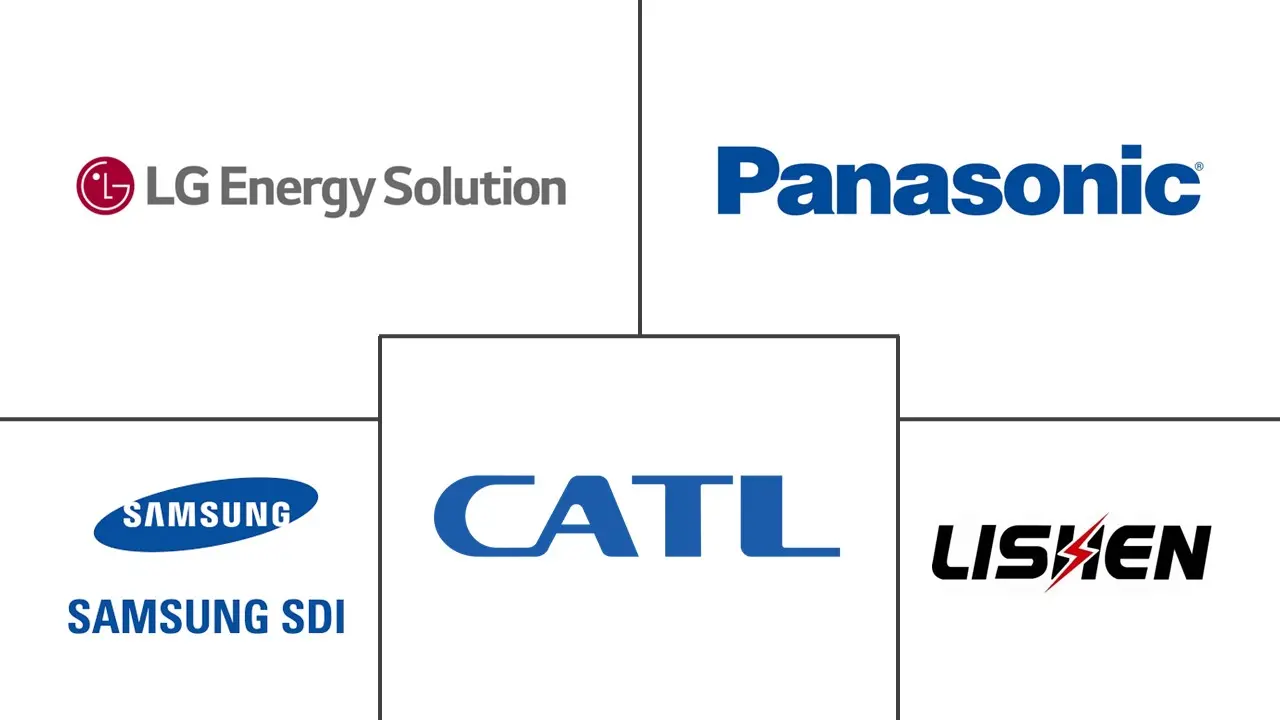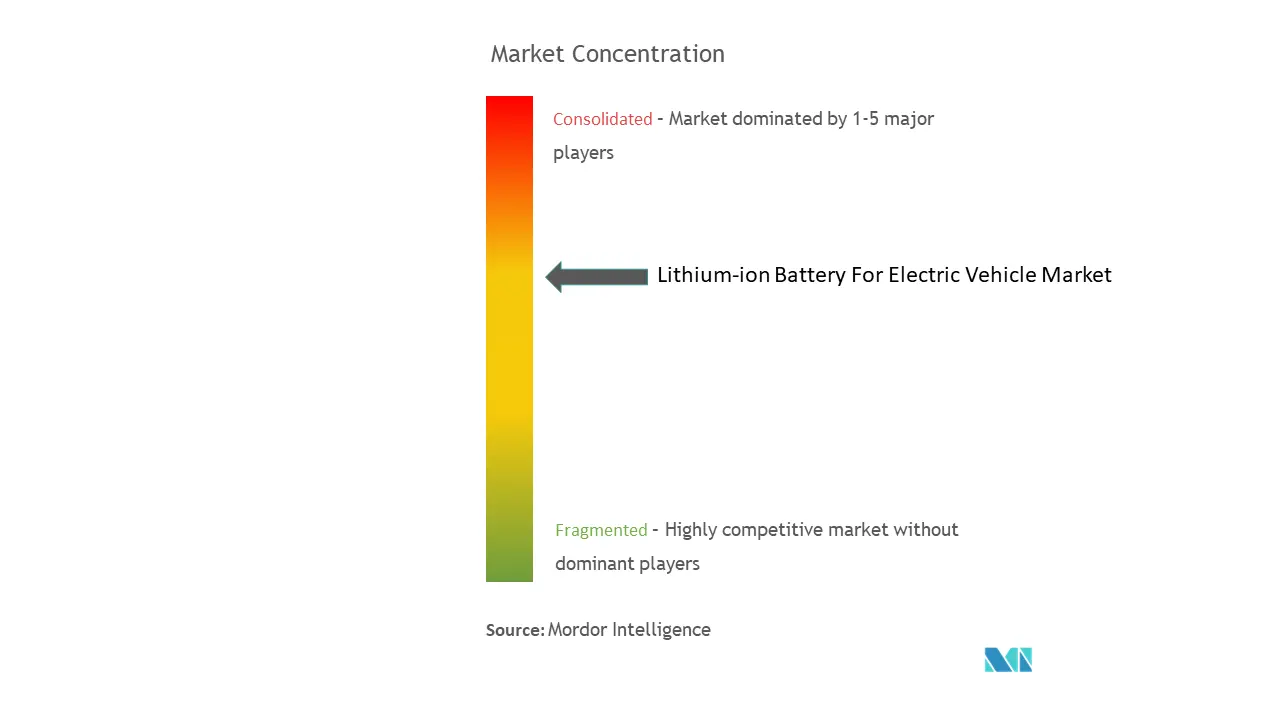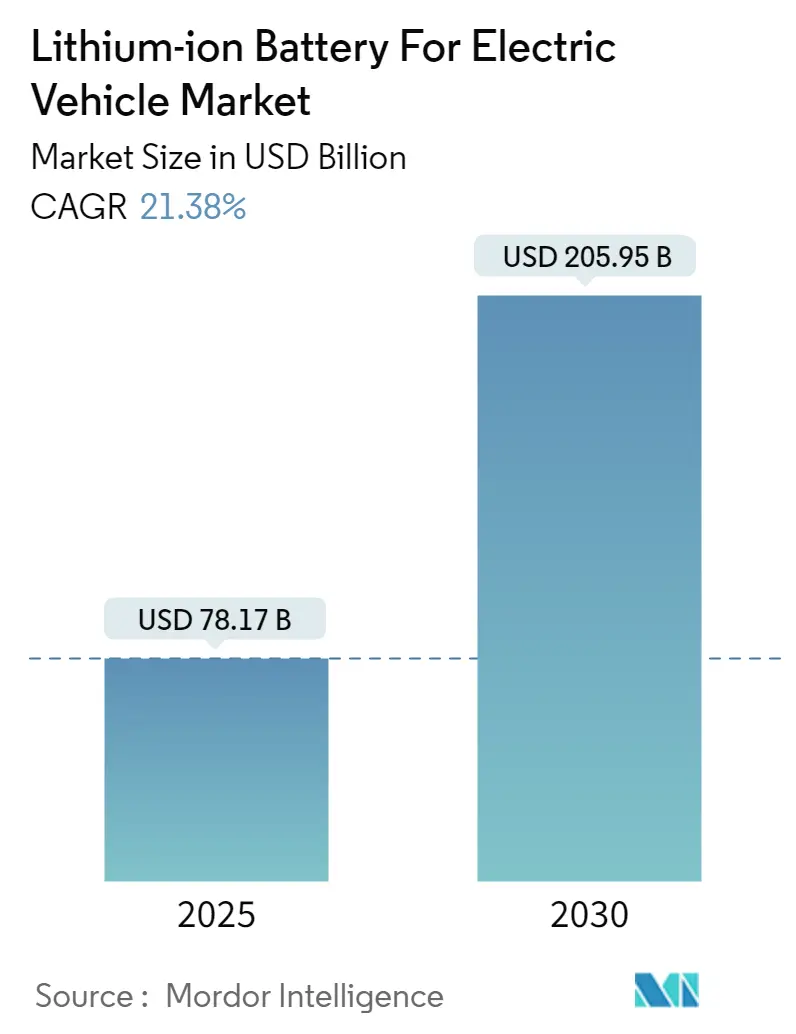
Lithium-ion Battery For Electric Vehicle Market Analysis
The Lithium-ion Battery For Electric Vehicle Market size is estimated at USD 78.17 billion in 2025, and is expected to reach USD 205.95 billion by 2030, at a CAGR of 21.38% during the forecast period (2025-2030).
Over the medium term, declining lithium-ion battery prices, increasing adoption of electric vehicles, and supportive government policies and initiatives are expected to drive the demand for lithium-ion batteries in the electric vehicle market during the forecast period.
On the other hand, the emerging alternative battery technologies and the demand-supply mismatch of raw materials are expected to hinder the market's growth during the forecast period. The adoption of solid-state lithium-ion batteries for electric vehicles is anticipated to create vast opportunities for lithium-ion batteries in the electric vehicle market. Due to the increasing adoption of electric vehicles in the region, Asia-Pacific is expected to be a dominant region for lithium-ion batteries in the electric vehicle market.
Lithium-ion Battery For Electric Vehicle Market Trends
Battery Electric Vehicle (BEV) Segment to Witness Significant Growth
- Battery electric vehicles (BEVs) are also commonly known as electric vehicles with an electric motor. BEVs are fully electric vehicles that typically do not include an internal combustion engine (ICE), fuel tank, or exhaust pipe and rely on electricity for propulsion. The vehicle's energy comes from the battery pack, which is recharged from the grid. BEVs are zero-emission vehicles, as they do not generate harmful tailpipe emissions or air pollution hazards caused by traditional gasoline-powered vehicles.
- The global automotive industry has been transforming, with electric vehicles, particularly battery electric vehicles (BEVs), gaining momentum and popularity. With the growing technological advancements, government support, and increasing environmental concerns, BEVs emerged as a promising solution to address the challenges of climate change and reduce reliance on fossil fuels.
- In recent years, the adoption of battery-electric vehicles has grown significantly worldwide. Improving battery technology has led to extended driving ranges and a surge in charging infrastructure, helping overcome the initial entry barriers. Automakers such as Tesla, BYD, Tata, Chevrolet, Nissan, and Ford are vital in popularizing BEVs, offering affordable models that appeal to a broader range of consumers.
- As per the International Energy Agency (IEA), the global battery electric vehicle (BEV) cars sales were around 9.5 million units (BEV cars) in 2023, an increase of over 30% from around 7.3 million units in 2022. Similarly, the total BEV car stocks worldwide reached around 28 million units in 2023. As the sales of BEVs continue to rise, the demand for EV batteries, such as lithium-ion batteries, has become increasingly vital.
- Countries have been implementing various initiatives and incentives to accelerate the adoption of BEVs. In the United States, federal tax credits, state rebates, and subsidies helped make EVs affordable and accessible to a broader audience. Several states have set ambitious targets to phase out internal combustion engine (ICE) vehicles and promote the use of electric cars. Therefore, the growing adoption of BEVs is anticipated to boost the demand for lithium-ion batteries over the forecast period.
- Several governments plan to boost the adoption of EVs in the coming years. In May 2024, the French government set a goal for the nation's carmakers to produce two million electric or hybrid vehicles by the end of the decade. Under a new medium-term planning agreement with the government, the industry is set to agree to an interim goal of 800,000 electric vehicle sales by 2027, up from 200,000 in 2022, according to a finance ministry briefing. Carmakers aim to increase sales of electric light utility vehicles to 100,000 annually over the same period, from only 16,500 in 2022. All these are expected to create a vast demand for rechargeable EV batteries, such as lithium-ion batteries, to support the growing battery electric vehicles on the roads in the region.
- Several Chinese carmakers have been looking to set up and expand EV manufacturing and assembly plants globally to ramp up sales. For example, Chery Auto, China's largest automaker by export volume, announced on April 2024 that it signed a joint venture with Spain's EV Motors to open its first European manufacturing site in Catalonia. The production is set to start later in 2024, with junior partner Chery producing its Omoda vehicles at the plant. Carmakers are considering building car factories in Britain by 2030.
- In March 2024, the Indian government approved a new USD 500-million-worth Electric Vehicle (EV) Policy, offering a range of incentives to draw investments from global EV companies and positioning India as a prime manufacturing hub for state-of-the-art EVs. Other objectives include providing Indian consumers access to cutting-edge EV models, expanding the Make in India ecosystem, lowering production costs, and fostering a competitive domestic auto manufacturing industry. Such a scenario is expected to impact the BEV manufacturing industry positively, which, in turn, boosts the demand for lithium-ion batteries for EV applications.
- Due to the abovementioned factors, the BEV segment is expected to dominate the lithium-ion battery for electric vehicle (EV) market over the forecast period.
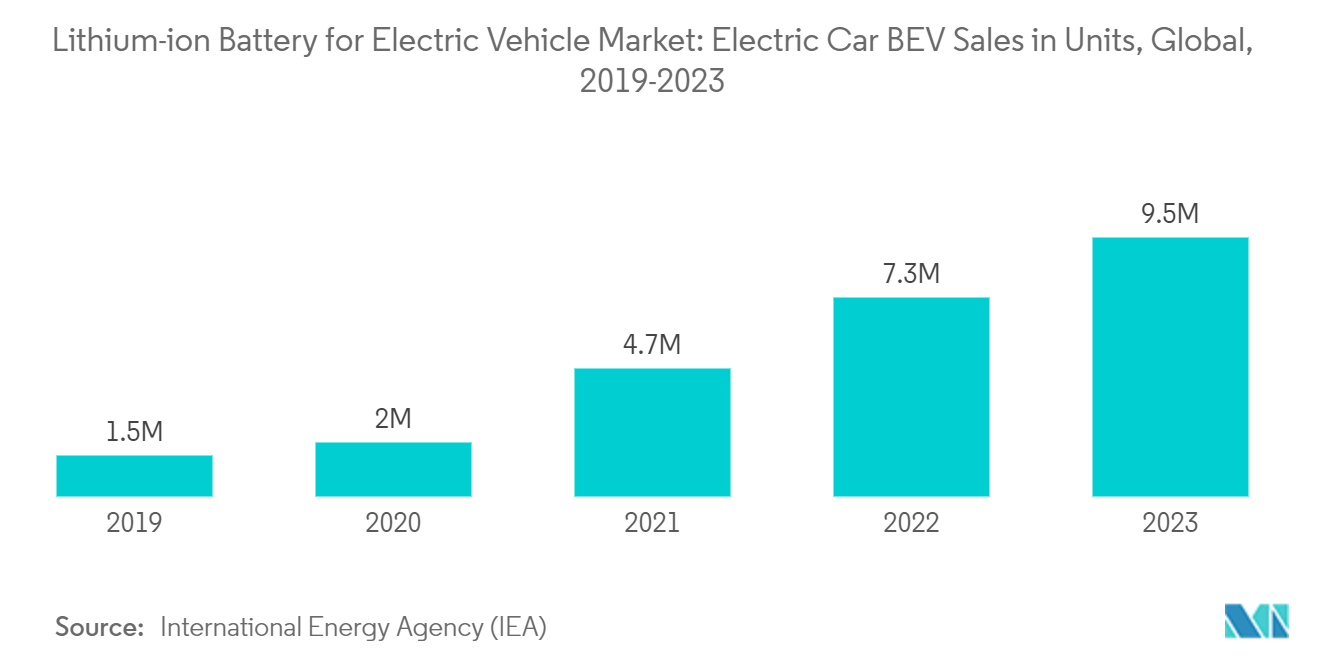
Asia-Pacific is Expected to Dominate the Market
- Asia-Pacific is expected to dominate the global lithium-ion battery for electric vehicle (EV) market, as the region is home to some of the world's largest and fastest-growing economies. Countries such as China, India, and Japan are experiencing a surge in the adoption of electric vehicles, where lithium-ion batteries are crucial battery chemistries.
- As per the International Energy Agency (IEA), the total EV car stocks, including (both BEV and PHEV) in China was around 21.8 million units in 2023. Similarly, India and Japan had approximately 0.15 million and 0.54 million units of EV car stocks in the same year, respectively. In 2023, China had an EV battery demand of about 417 GWh per year, or about 54% of the world demand in 2023, recording over 32% surge from 2022. This highlights the importance of the country's dominance in EV batteries.
- Asia-Pacific is also emerging as a manufacturing hub for electric vehicles and battery systems, which is expected to witness significant developments in rechargeable batteries such as lithium-ion batteries. Major automotive manufacturers in China, South Korea, and Japan are expected to accelerate the region's lithium-ion battery manufacturing capacity.
- As per the International Energy Agency (IEA), the lithium-ion battery manufacturing capacity in Asia-Pacific is expected to grow significantly in the coming years, with China leading the way. The agency estimated that the Chinese lithium-ion battery manufacturing capacity will rise to 4.65 TWh in 2030 from around 1.20 TWh in 2022.
- The region has been seeing developments in the lithium-ion batteries. In June 2024, Indian battery maker Amara Raja Energy and Mobility signed a licensing agreement with Gotion-InoBat-Batteries (GIB), a unit of China-based Gotion High Tech Co, to produce lithium-ion batteries in India. GIB EnergyX Slovakia, a joint venture between Gotion and Slovakia-based InoBat, will license Gotion's lithium iron phosphate technology for lithium-ion cells to a unit of Amara Raja.
- Under the licensing agreement, the Indian company will gain access to cell technology IP, support for establishing Gigafactory facilities, and integration into Gotion's global supply chain network. Gotion, whose largest shareholder is the German automaker Volkswagen, specializes in lithium-ion rechargeable batteries for new-energy vehicles. Indian automakers mainly import EV batteries from China and South Korea, and domestic battery suppliers have invested in developing lithium-ion battery production capabilities within the country in recent years.
- Asia-Pacific is also home to some of the world's largest producers and suppliers of critical raw materials used in lithium-ion batteries, such as lithium, cobalt, and graphite. This abundant availability of raw materials, coupled with the region's strong manufacturing capabilities, has created a favorable environment for the growth of the lithium-ion battery market.
- For instance, Indonesia holds approximately 22% of the global nickel reserves. Similarly, the Western Australia region has 24% of the global lithium reserves, which makes Asia-Pacific ideal for lithium-ion battery development and manufacturing.
- Therefore, as per the abovementioned points, Asia-Pacific is expected to be the dominant region for lithium-ion batteries in the electric vehicle market during the forecast period.
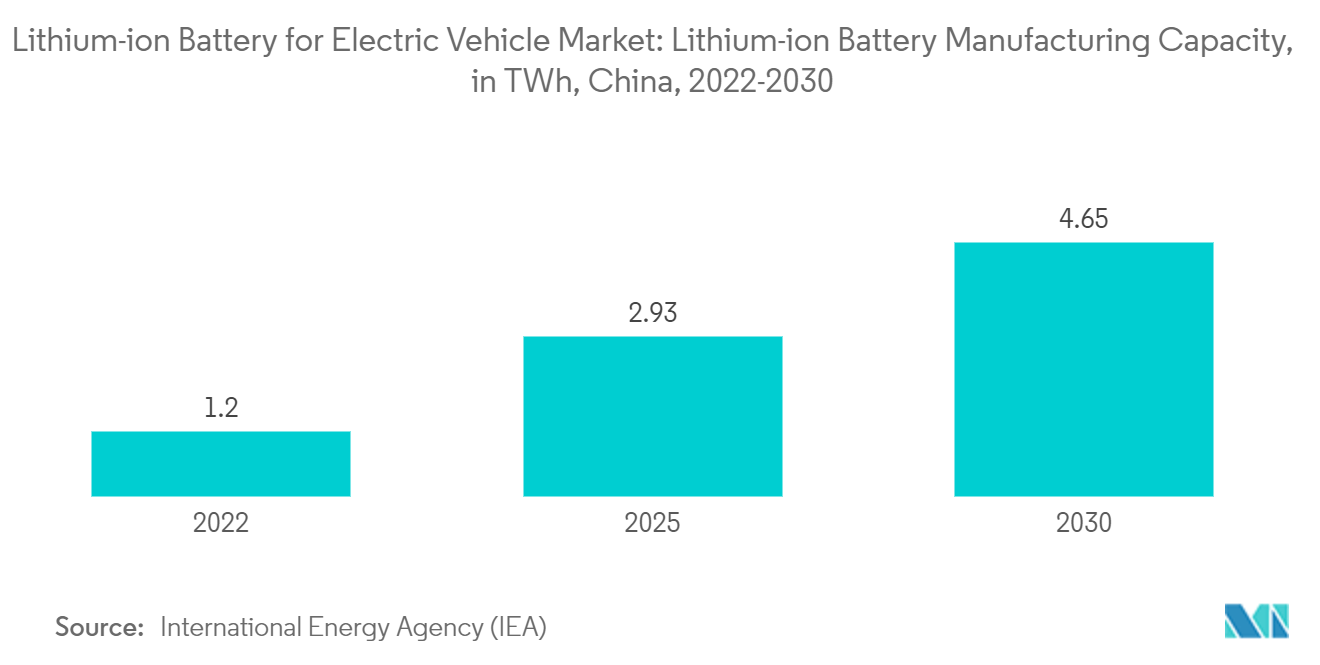
Lithium-ion Battery For Electric Vehicle Industry Overview
The lithium-ion battery for the electric vehicle market is semi-consolidated. Some key players in the market include Panasonic Corporation, Samsung SDI Co. Ltd, Contemporary Amperex Technology Co. Ltd (CATL), LG Energy Solution Ltd, and Tianjin Lishen Battery Joint-Stock Co. Ltd.
Lithium-ion Battery For Electric Vehicle Market Leaders
-
Panasonic Corporation
-
Samsung SDI Co., Ltd.
-
Contemporary Amperex Technology Co. Ltd (CATL)
-
Tianjin Lishen Battery Joint-Stock Co., Ltd.
-
LG Energy Solution Ltd.
- *Disclaimer: Major Players sorted in no particular order
Lithium-ion Battery For Electric Vehicle Market News
- June 2023: Tata Group signed an outline on constructing a lithium-ion cell factory, with an investment of about INR 130 billion (USD 1.58 billion), as part of India’s efforts to create its electric vehicle supply chain. A joint statement on the MoU between Tata's unit Agratas Energy Storage Solutions and the government of the western state of Gujarat stated that the work on the plant was expected to start in less than three years and to be based in Sanand, northern Gujarat. The plant is expected to have an initial manufacturing capacity of 20 GWh, which could be doubled in a second expansion phase.
- November 2023: The US Department of Energy (DOE) announced up to USD 3.5 billion from the Infrastructure Law to boost domestic production of battery materials and advanced batteries nationwide. It is a part of President Biden's Investing in America agenda, and the funding is expected to create new, retrofitted, and expanded domestic facilities for battery components, battery-grade processed critical minerals, cell and pack manufacturing, and battery precursor materials. These are critical in supporting clean energy industries like renewable energy and electric vehicles.
- August 2023: Amara Raja Batteries announced plans to expand into the two-wheeler EV market through chargers and batteries to expand to triple its lithium-ion business. Amara Raja, whose customers are only in the three-wheeler EV market, received about 2.5% of its total revenue from its lithium-ion battery business, while the rest of INR 103.85 billion (USD 1.25 billion) in FY 2023 was from its flagship lead-acid storage battery-making unit. The company, which owns the Amaron battery brand, aims to enter the two-wheeler EV market with chargers first and eventually through battery packs as it expands its 'new energy' segment.
Lithium-ion Battery For Electric Vehicle Industry Segmentation
A lithium-ion battery for electric vehicles (EVs) is a rechargeable battery commonly used to power electric cars and other electric transportation. This battery technology is known for its high energy density, long cycle life, and lightweight design. It enables efficient storage and delivery of electrical energy. Lithium-ion batteries contain cells containing an anode, cathode, separator, and electrolyte. These batteries offer a high power-to-weight ratio, excellent energy efficiency, and reduced self-discharge compared to other rechargeable batteries, making them a preferred choice for modern electric vehicles.
The lithium-ion battery for electric vehicle market is segmented into vehicle type, propulsion type, and geography. By vehicle type, the market is segmented into passenger vehicles, commercial vehicles, and other vehicles (bikes, scooters, etc.), and by propulsion type into battery electric vehicles (BEV), hybrid electric vehicles (HEV), and plug-in hybrid electric vehicles (PHEV). The report also covers the market size and forecasts for the lithium-ion battery for the electric vehicle market across major regions in terms of revenue in USD for all the above segments.
| Vehicle Type | Passenger Vehicles | ||
| Commercial Vehicles | |||
| Other Vehicles (Bikes, Scooters, etc.) | |||
| Propulsion Type | Battery Electric Vehicle (BEV) | ||
| Plug-in Hybrid Electric Vehicle (PHEV) | |||
| Hybrid Electric Vehicles (HEV) | |||
| Geography | North America | United States | |
| Canada | |||
| Rest of North America | |||
| Europe | Germany | ||
| United Kingdom | |||
| France | |||
| Italy | |||
| Spain | |||
| Nordic | |||
| Russia | |||
| Rest of Europe | |||
| Asia-Pacific | China | ||
| India | |||
| Japan | |||
| South Korea | |||
| Thailand | |||
| Malaysia | |||
| Indonesia | |||
| Vietnam | |||
| Rest of Asia-Pacific | |||
| Middle East and Africa | Saudi Arabia | ||
| United Arab Emirates | |||
| South Africa | |||
| Egypt | |||
| Nigeria | |||
| Qatar | |||
| Rest of Middle East and Africa | |||
| South America | Brazil | ||
| Argentina | |||
| Chile | |||
| Rest of South America | |||
Lithium-ion Battery For Electric Vehicle Market Research FAQs
How big is the Lithium-ion Battery For Electric Vehicle Market?
The Lithium-ion Battery For Electric Vehicle Market size is expected to reach USD 78.17 billion in 2025 and grow at a CAGR of 21.38% to reach USD 205.95 billion by 2030.
What is the current Lithium-ion Battery For Electric Vehicle Market size?
In 2025, the Lithium-ion Battery For Electric Vehicle Market size is expected to reach USD 78.17 billion.
Who are the key players in Lithium-ion Battery For Electric Vehicle Market?
Panasonic Corporation, Samsung SDI Co., Ltd., Contemporary Amperex Technology Co. Ltd (CATL), Tianjin Lishen Battery Joint-Stock Co., Ltd. and LG Energy Solution Ltd. are the major companies operating in the Lithium-ion Battery For Electric Vehicle Market.
Which is the fastest growing region in Lithium-ion Battery For Electric Vehicle Market?
Asia Pacific is estimated to grow at the highest CAGR over the forecast period (2025-2030).
Which region has the biggest share in Lithium-ion Battery For Electric Vehicle Market?
In 2025, the Europe accounts for the largest market share in Lithium-ion Battery For Electric Vehicle Market.
What years does this Lithium-ion Battery For Electric Vehicle Market cover, and what was the market size in 2024?
In 2024, the Lithium-ion Battery For Electric Vehicle Market size was estimated at USD 61.46 billion. The report covers the Lithium-ion Battery For Electric Vehicle Market historical market size for years: 2019, 2020, 2021, 2022, 2023 and 2024. The report also forecasts the Lithium-ion Battery For Electric Vehicle Market size for years: 2025, 2026, 2027, 2028, 2029 and 2030.
Lithium-ion Battery For Electric Vehicle Industry Report
Statistics for the 2025 Lithium-ion Battery For Electric Vehicle market share, size and revenue growth rate, created by Mordor Intelligence™ Industry Reports. Lithium-ion Battery For Electric Vehicle analysis includes a market forecast outlook for 2025 to 2030 and historical overview. Get a sample of this industry analysis as a free report PDF download.

